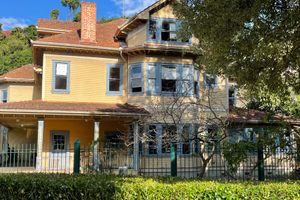
Few old constructions remain standing when they find themselves in the way of so-called progress. It’s a story all too common in urban areas: out with decades-old houses full of character and history, in with soulless structures of steel and glass. The Gomm House is a rare exception to this rule—sort of.
The Gomm House was built in Curitiba’s wealthy neighborhood of Batel for Henry Gomm, a British businessman who traded yerba mate in the state of Paraná. Finished in 1913, it stood out for its size and its architectural style, which curiously mimicked not the houses in Gomm’s native England, but those in New England. The estate was almost five acres in area, including a vast stretch of woodland.
In the 1920s, Henry was made honorary consul of England in Paraná. His wife, Isabel Withers Gomm, was prominent in her own way, being credited with having brought the Red Cross to Curitiba. The couple had an active social life, entertaining local figures and hosting international ones.
One of their sons, Harry Blas Gomm, followed in his father’s footsteps and served as a British vice-consul, between 1940 and 1955. Harry’s wife, Luísa Bueno Gomm, was a pioneer in her own right—among other accomplishments, she was the first woman in Paraná to get a pilot’s license. Reportedly, while Harry and Luísa were at the helm, the Gomm House became even more of a hub for the local elite.
Things started to change around 1958, after Harry and Luísa moved out. No longer housing any of the family members, the building was put up for lease. Along the decades, it went on to have many incarnations, among them as a medical center and as the first home of Casacor, a now-annual design and architecture event.
In the late 1980s, the Gomm heirs sold the property to a development group. Worrying that the house might be torn down, preservationists worked to save it. The mayor at the time declared the estate an area of public interest and expressed the intention to turn it into an urban park. In 1989, the house and its surroundings were given protection status under the law and included in the state’s Register of Historic Places.
The park idea didn’t get much traction, though, and the conservation tactics didn’t dissuade the developers from building in the property that they owned. Initially, they intended to set up either a private club or a hotel. When those plans didn’t pan out, they decided on a luxury mall. Since the law prohibited them from demolishing the house, they sought permission to move it. The authorization came in 1999, and soon after the delicate relocation process started. The Gomm House was disassembled, had some damaged parts restored, and was rebuilt in its current address, in the back of the lot.
After it reopened in 2004, now in the hands of the state government, the house served for a few years as a campus for the state’s Music and Fine Arts College. In 2013 (the same year the mall opened), it became the home of the agency known as Coordenação do Patrimônio Cultural, which oversees cultural heritage and historical patrimony in Paraná—a somewhat ironic outcome.
With the trials and tribulations that it’s been through, the Gomm estate came to be a dual symbol. On one hand, it’s an embodiment of the value of conservation efforts; at the same time, it’s a testament to how the wants and needs of private economic interest are often favored and accommodated for by the powers that be.
Though the house still stands, the green area around it got much smaller over the decades. Also in 2013, a grassroots movement formed and eventually prevented the developers from opening an access road that would benefit the mall and cut down even more trees.
The remaining woods are now part of a small park run by the city government. Murals tell visitors about the Gomm family and British immigration in Paraná. The park also pays tribute to British culture, with items like a red phone booth, murals about notable British figures, and a garden themed after Beatrix Potter.
